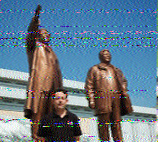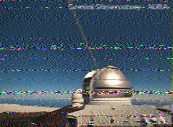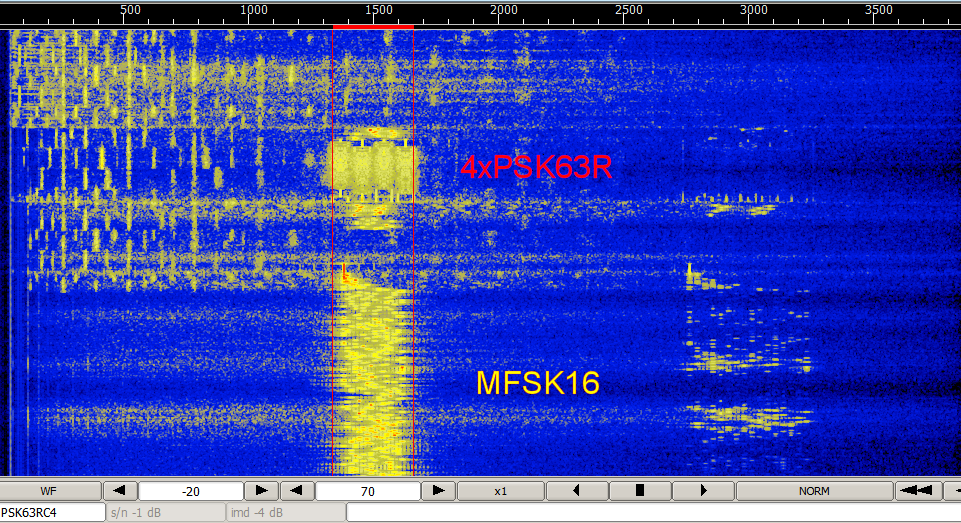www.rhci-online.net/radiogram/radiogram.htm
██╗ ██╗ ██████╗ █████╗ ██████╗ █████╗ ██████╗ ██╗ ██████╗ ██████╗ ██████╗ █████╗ ███╗ ███╗ ██║ ██║██╔═══██╗██╔══██╗ ██╔══██╗██╔══██╗██╔══██╗██║██╔═══██╗██╔════╝ ██╔══██╗██╔══██╗████╗ ████║ ██║ ██║██║ ██║███████║ ██████╔╝███████║██║ ██║██║██║ ██║██║ ███╗██████╔╝███████║██╔████╔██║ ╚██╗ ██╔╝██║ ██║██╔══██║ ██╔══██╗██╔══██║██║ ██║██║██║ ██║██║ ██║██╔══██╗██╔══██║██║╚██╔╝██║ ╚████╔╝ ╚██████╔╝██║ ██║ ██║ ██║██║ ██║██████╔╝██║╚██████╔╝╚██████╔╝██║ ██║██║ ██║██║ ╚═╝ ██║ ╚═══╝ ╚═════╝ ╚═╝ ╚═╝ ╚═╝ ╚═╝╚═╝ ╚═╝╚═════╝ ╚═╝ ╚═════╝ ╚═════╝ ╚═╝ ╚═╝╚═╝ ╚═╝╚═╝ ╚═╝
RSID: <<2013-08-17T16:01Z MFSK-16 @ 17860000+1500>>
Welcome to VOA Radiogram, program 22.
Here is the lineup for today's program:
3:04 MFSK16: Program preview (now)
4:50 MFSK32: VOA Spanish logo and news re VOA app*
1:46 MFSK32: VOA Chinese logo and sample text*
3:26 MFSK32: VOA News re benefits of hot chocolate
1:22 MFSK32: VOA Radiogram logo and addresses
4:43 MFSK64: VOA's W7VOA visits North Korea
1:18 MFSK32: Photo of W7VOA in Pyongyang
3:28 MFSK64/Flmsg: VOA's KI4FNF on search for extraterrestrials
1:18 MFSK32: Photo of Gemini Observatory
1:12 MFSK16: Closing announcements
0:16 Surprise mode of the week
*To view Spanish with accents and the Chinese characters, use
UTF-8 character set. In Fldigi: Configure > Colors & Fonts.
Please send reception reports to radiogram@voanews.com
And visit voaradiogram.net
Twitter: @VOARadiogram
VOA Radiogram now changes to MFSK32...
RSID: <<2013-08-17T16:05Z MFSK-16 @ 17860000+1500>>
Sending Pic:225x36C;
![]()
La VOA ya tiene su app
Ya están disponibles las aplicaciones móviles de la Voz de
América tanto para iOS en la tienda iTunes de Apple, como para
android en el Google Play Store.
Voz de América - Redacción
12.08.2013
"Todo está disponible ahora en un solo lugar", dice el director
de la Voz de América (VOA), David Ensor, al anunciar el servicio
de aplicaciones para móviles que ha sido lanzado en 43 idiomas.
Las últimas noticias de la Voz de América en español
www.voanoticias.com y en otros 42 diferentes idiomas, ahora serán
más de acceder tras el lanzamiento del nuevo servicio de
aplicaciones para teléfonos inteligentes y tableta para iPhones,
iPads y dispositivos que operan con Android.
"Este es un gran paso" para la VOA, porque "estas aplicaciones
potencia el acceso a través de Internet a toda una nueva
generación de usuarios de servicios móviles."
Además del servicio en español, la Voz de América lanzó las
aplicaciones en chino, ruso, suahili, turco, inglés y muchos más.
Ahora las noticias, videos, audios, las fotografías, la
programación de radio y televisión de la Voz de América y todos
los recursos están a la mínima distancia de apenas un toque sobre
la pantalla de dos de las plataformas móviles más populares del
mundo.
El iOS de Apple y las aplicaciones de Google Android son
gratuitos y ofrecen las últimas noticias e información en texto,
audio y video. Incluso se puede elegir las historias preferidas y
descargarlas para verlas sin conexión o para ver o escuchar más
tarde, cuando la recepción inalámbrica pueda tener una calidad
más baja.
El contenido se divide por regiones, así como por temas, con
secciones de noticias especiales sobre ciencia y tecnología,
salud, entretenimiento.
Los usuarios pueden personalizar las fuentes y el contenido de 43
de los idiomas de la VOA y las aplicaciones se han diseñado de
forma que son interactivas, de modo que usted puede hacer
búsquedas muy fácilmente y cambiar de historias solamente
deslizando un dedo sobre la pantalla del dispositivo móvil como
si estuviera leyendo un periódico o una revista.
"Otra de las características con la que estamos muy entusiasmados
es la capacidad que las aplicaciones dan a aquellos que hacen
periodismo ciudadano de utilizar sus teléfonos móviles para
compartir fotos, audios, textos o vídeos directamente con los
editores de la VOA en Washington", subraya el director de la Voz
de América, David Ensor.
Los usuarios también pueden compartir sus historias preferidas en
Facebook y Twitter.
Sending Pic:190x38C;
![]()
黑莓公司可能求售
美国之音
08.12.2013
陷入困境的智能手机制造商黑莓公司说,它可能寻求其他公司并购。
总部设在加拿大的黑莓公司星期一说,它会考虑寻求并购或者和其他公司建立合资公司或伙伴关系。这家公司最近推出了三款新的智能手机,但是,它的市场份额却在继续缩小。
|
Joint Ventures oder eine Partnerschaft mit anderen Unternehmen kämen dabei auch in Betracht.. Das Unternehmen hat vor kurzem drei neue Smartphones herausgebracht, sein Marktanteil schrumpft aber weiter.
|
RSID: <<2013-08-17T16:11Z MFSK-32 @ 17860000+1500>>
VOA NEWS
Hot Chocolate May Help Keep Older Brains Healthy
Faith Lapidus
August 07, 2013
As if we needed another reason to love chocolate, it turns out
hot cocoa could be good for you. A new study says drinking two
cups of hot chocolate a day may help older brains remain sharp.
A common form of dementia is caused by problems in the supply of
blood to the brain. Harvard Medical School neurologist Farzaneh
Sorond wanted to understand how blood flow in the brain affected
thinking skills. She studied a group of 60 older people, with an
average age of 73, who did not have dementia. Eighteen, however,
had impaired blood flow in their brain.
The participants drank two cups of hot cocoa a day for a month.
They were given tests of memory and thinking, and Sorond used an
ultrasound to measure blood flow during the tests. She found that
blood flow to the working parts of the brain increased with the
cognitive tasks.
By the end of the study, the participants who had impaired blood
flow had significantly improved their scores on the tests, and
showed an 8.3 percent improvement in blood flow. The other
participants had no change in their performance and blood flow.
There is a hypothesis that the antioxidant flavanol, which is
found in cocoa, helps cognition. Alzheimer's expert Paul
Rosenberg, who wrote an editorial accompanying Sorond's study in
the journal Neurology, said that theory, however, did not hold
up.
"Her findings go against that. She [Sorond] tested cocoa that was
rich in flavanol and poor in flavanol, and she found no
difference," said Rosenberg.
Rosenberg, of The Johns Hopkins University School of Medicine,
called her study "an important first step" toward future studies,
though, that could lead to better drugs or treatments for
Alzheimer's disease.
"Dr. Sorond's a friend, so we've talked about this, and neither
of us are quite ready to jump out and say, 'take cocoa.' But it's
possible there may be a drug to develop that's sitting inside
your cocoa," he said.
And until then, we can enjoy hot chocolate - maybe with some
whipped cream - simply because it tastes good!
http://www.voanews.com/content/hot-chocolate-may-help-keep-older-brains-healthy/1725593.html
Sending Pic:330x30C;
![]()
Harvard Medical School has not studied this yet, but
experimenting with digital text and images is actually the best
thing to keep older brains healthy.
Please send reception reports to radiogram@voanews.com
And visit voaradiogram.net
Twitter: @VOARadiogram
VOA Radiogram now changes to MFSK64 for two VOA News stories, the
second of which will be in Flmsg format...
RSID: <<2013-08-17T16:16Z MFSK-64 @ 17860000+1500>>
VOA Radiogram in MFSK64...
A View of North Korea from Inside
VOA News
August 01, 2013
For reporters, some parts of the world are simply impenetrable.
High on that list is North Korea, one of the most reclusive and
politically isolated countries in the world.
VOA Asia Correspondent Steve Herman {W7VOA] was able to get
inside for nine days.
Herman was allowed entry to report on 88-year-Thomas Hudner, an
American war veteran, who returned to North Korea hoping to
recover the remains of his wingman, whose aircraft crash landed
during a fierce Korean War battle 63 years ago. Hudner was unable
to complete his mission due to serious flooding in the region.
And Steve, accompanied by North Korean escorts, got a rare look
at Pyongyang and other areas. We spoke to him in Tokyo, shortly
after his trip to find out what it was like.
VOA: Steve, you have just returned from a nine-day-long trip to
North Korea. That in and of itself is a rather newsy thing to
do.
Herman: "Well obviously you never really can understand a place
until you've been there, and we've had a tiny bit of glimpse by
being able to spend time not only in Pyongyang, but also to get
out to some of the rural areas, places other foreign
correspondents have not been able to go, nor are on the typical
tours offered to Westerners."
"Also, our route was altered a little bit when we left Pyongyang
due to the serious flooding, so we were on some alternate roads
that we were not intended to be traveling on. And we saw some
things that the typical foreigners going into the DPRK, the
Democratic People's Republic of Korea, do not see, such as how
people in the rural areas live, which is obviously quite a
contrast from the presentation of central Pyongyang, which has
high-rise buildings, where the electricity stays on most of the
time – at least while we were there – and has fancy restaurants,
even a few outside the hotels, and such activities as bowling
alleys and all the major tourist attractions, most of them tied
to the glorifying the state and its leaders past and present."
VOA: Describe what it felt like to be in the capital versus all
the years you're spent in Seoul. Are these really two different
Koreas? And also, a little bit about what these rural areas are
like.
Herman: "Pyongyang obviously cannot rival Seoul. Seoul is one of
the most developed cities in the world, and Pyongyang is nowhere
near that. That said, Pyongyang does have high-rise buildings. It
does have traffic, not as much as Seoul or any even much smaller
cities we might find in Asia or Europe. And there were no overt
signs of poverty or anyone starving in the capital. Everyone
looked fairly well-fed and well-dressed. But once you get to the
outskirts of the city, and especially into the rural areas, that
view changes very quickly."
"We got into two areas in the North of Pyongyang. One was a city
called Hyangsan which has some tourist attractions nearby. And
[one] in the general vicinity called Kujang, where we saw much
different scenes than in Pyongyong.
The apartment buildings were much more dilapidated. The main
mode of transport for people who were not on foot was on bicycle.
We saw people pushing carts, pulling carts, carts being driven by
oxes.
"We also saw what maybe be a little bit of entrepreneurship, or
capital enterprise, going on in the streets of these small
cities, where people set up stalls on the roadside, selling food.
Another was a young lady sitting under a red umbrella and had a
blue box in which she was selling what appeared to be some sort
of bread and drinks out of it."
"We were not allowed to stop and talk to any of these people.
The other thing that you really notice, both in the city and the
countryside, is the pervasiveness of the military and military
vehicles. We saw a lot of not only soldiers riding in the backs
of military trucks to get around. Some of these may be on work
detail because there was quite serious flooding while we were
there. And we saw these propaganda loudspeaker trucks going
around, calling people out in the recovery effort in the
flooding."
VOA: You never spoke to any ordinary North Korean citizens, is
that correct?
Herman: "We did have interaction with people in Pyongyang that we
came up to in some of the tourism sites. These were impromptu
encounters, so I have no evidence whatsoever that anything was
staged."
"Also, we did meet in [the] countryside and interact with tour
guides…we could ask the tour guides anything we wanted. But we
did not stop in the areas that I would have liked to stop in the
countryside and talk to the farmers. We saw quite an abundance
of crops….we saw fields and fields of corn, rice and, at least in
this area that we were in, the harvest this year looked it was
going to be quite bountiful."
VOA: Sounds like a slightly different picture than what we often
hear from United Nations' agencies regarding crops and food
stocks. Would you say it was a sign of prosperity?
Herman: "Well outside Pyongyang, I wouldn't call it prosperity.
People seemed to be getting by, but they could not be called
wealthy by any stretch of the imagination. There is obviously in
the capital, in Pyongyang, an elite, people who work for the
government. There are some private vehicles, some of these were
European luxury vehicles, but obviously compared to any other
major city in the world, you don't see the large number of
private cars that you would see in those places."
VOA: Steve, in all your years in Seoul, was what you experienced
in North Korea what you had expected? Was it what you had
imagined?
Herman: "Not to some degree. I expected that Pyongyang would be
much more of a 'Potemkin village,' which, in other words, behind
a few facades that there really wouldn't be much of substance
there. That obviously was not the case in Pyongyang."
http://www.voanews.com/content/a-view-of-north-korea-from-inside/1715202.html
Radiogram now changes to MFSK32 for a photo of Steve Herman,
W7VOA, at Mansu Hill in Pyongyang on July 25, 2013. Then back to
MFSK64 for more VOA News...
RSID: <<2013-08-17T16:21Z MFSK-32 @ 17860000+1500>>
Sending Pic:158x142C;

RSID: <<2013-08-17T16:22Z MFSK-64 @ 17860000+1500>>
... start
[WRAP:beg][WRAP:lf][WRAP:fn VOAR22_MFSK64_ET.p2s]<flmsg>1.1.29
:hdr_fm:20
MFSK 20131308173224
:hdr_ed:20
MFSK 20131308161154
<plaintext>
:tt:58 Scientists Renew Effort Looking for Intelligent Alien Life
:to:28 Worldwide shortwave audience
:fm:13 VOA Radiogram
:dt:17 17-18 August 2013
:tm:35 UTC Sat 1600, Sun 0230, 1300, 1930
:sb:58 Scientists Renew Effort Looking for Intelligent Alien Life
:mg:3917 <svg version="1.1" width="225" height="96">
<polygon fill="#0001FE" points="50,57 66,1 99,1 68,95 34,95 0,1 35,1"/>
<polygon fill="#0001FE" points="177,39 192,95 225,95 195,1 160,1 127,95 161,95"/>
<circle fill="#FFFFFF" cx="113" cy="48" r="47"/>
<circle fill="#999999" cx="113" cy="48" r="22"/>
</svg>
<H2>Scientists Renew Effort Looking for Intelligent Alien Life</H2>
<b>George Putic, KI4FNF
August 12, 2013</b>
After the 1982 megahit E.T. the Extraterrestrial, the search for alien intelligent life was much in focus. And although no evidence has yet been found, scientists are still watching and listening to deep space. Now, recent
technological advances are giving them additional hope.
The search for extraterrestrials is being done with telescopic "eyes" and "ears".
Michael Liu, an astronomy professor at the University of Hawaii, in Honolulu, uses an optical telescope to look for planets orbiting distant stars.
Liu says until recently, earth-bound telescopes could not provide extremely sharp images of distant stars because of the refraction of light passing through earth's atmosphere. But that has changed.
"One of the technological advances that has happened in the last 15 years is that telescopes are now equipped with technology known as adaptive optics, that essentially allows you a way to measure in real time the trembling
of the earth’s atmosphere and correct for those images," Liu said.
Liu says the images of stars are now more than 10 times sharper than before.
Scientists can not actually see distant planets. Instead they calculate their presence by measuring their gravitational pull at their stars. It is also possible to detect heat emitted by very young planets that provides clues
to their physical properties, like how big they are, how much energy they put out, even the materials they are made of.
"Every piece of evidence we’ve found today suggest that planetary systems, planets around the stars, are common," said astronomer Liu. "And we’re getting ever and ever closer -- not quite yet, but we’re getting
very close to finding planets just like our earth, around stars just like our sun. And that almost seems inevitable."
<b>Signals must have a structure</b>
Other scientists are using radio telescopes -- huge dish antennas or antenna arrays -- listening to radio emissions from deep space.
Dr. Alan Penny, an astronomy professor at the University of St. Andrews, Scotland, is chairman of the United Kingdom's Search for Extraterrestrials group (UKSETI), which plans to connect all radio telescopes in Britain into a
huge network in search of intelligent alien life.
Penny says noise and natural signals from stars and quasars are chaotic, while signals from intelligent life must have a structure.
"There’s no natural source, there’s no star or quasar that can do it. So when you take your picture of the sky and you look at the colors, the equivalent of the colors, if there is one sharp band -- that must be
artificial, which means it must be intelligence."
But the sky is enormous. Where exactly will the astronomers look for extraterrestrial life?
Perhaps they’re like us and they live on other planets and they emit strong radio waves, then you point your telescopes at nearby stars which you know have planets, and just within the last 10 years we’ve been
detecting planets around nearby stars," Penny said.
Penny says funding for the search will be provided by private grants and he expects the UKSETI network to be fully operational in about two years. In the meantime, other scientists keep looking for extraterrestrial life
because, they say, the chances are high that we are not alone.
<a href="http://www.voanews.com/content/scientists-renew-effort-looking-for-intelligent-alien-life/1728495.html">www.voanews.com/content/scientists-renew-effort-looking-for-intelligent-alien-life/1728495.html</a>
[WRAP:chksum DD65][WRAP:end]
... end
|
Scientists Renew Effort Looking for Intelligent Alien Life | ||
|
TO: Worldwide shortwave audience | ||
|
FROM: VOA Radiogram | ||
|
SUBJ: Scientists Renew Effort Looking for Intelligent Alien Life | ||
|
DATE: 17-18 August 2013 | ||
|
TIME: UTC Sat 1600, Sun 0230, 1300, 1930 | ||
|
MESSAGE: | ||
| ||
RSID: <<2013-08-17T16:26Z MFSK-32 @ 17860000+1500>>
Sending Pic:173x127C;

RSID: <<2013-08-17T16:27Z MFSK-16 @ 17860000+1500>>
Please send reception reports to radiogram@voanews.com.
And visit voaradiogram.net.
Twitter: @VOARadiogram
Thanks to colleagues at the Edward R. Murrow shortwave
transmitting station in North Carolina.
I'm Kim Elliott. Please join us for the next VOA Radiogram.
This is VOA, the Voice of America.
RSID:
<<2013-08-17T16:28Z 4xPSK63R
@ 17860000+1500>>
Thank you for decoding the modes on VOA Radiogram via the Edward
R Murrow transmitting station in North Carolina.

www.rhci-online.net/radiogram/radiogram.htm
|
QTH: |
D-06193 Petersberg (Germany/Germania) |
|
Ant.: |
Boomerang 11-mBand |
|
RX: |
ICOM IC-R75 + IF-mixer |
|
Software IF |
SAM - USB (con STUDIO1 - Software italiano per SDR) |
|
Software: AF |
Fldigi 3.21.74 + flmsg 1.1.32 |